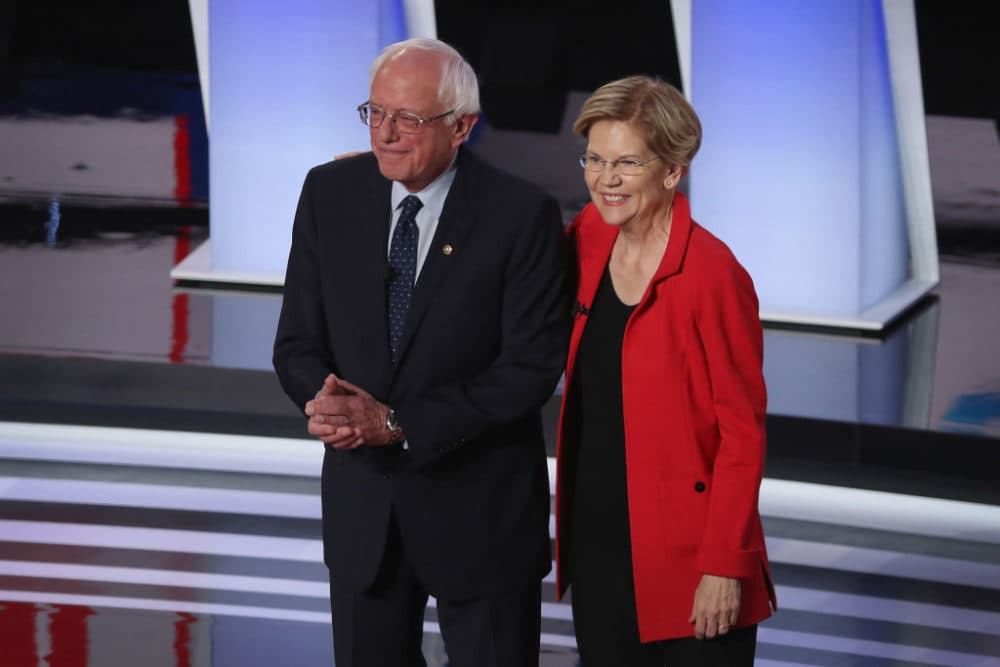Advertisement
A Historical Look At Whether A Democrat Can Win By Playing To The Progressive Base
Resume
The pool of potential candidates to take on President Trump in the 2020 election is split between two types of Democrats.
Progressives like Bernie Sanders and Elizabeth Warren tout plans that a few years ago were outside the U.S. political mainstream like “Medicare for All,” while moderate candidates like Joe Biden and Peter Buttigieg favor more middle-leaning stances like Buttigieg’s “Medicare for All Who Want It” plan.
The last time a candidate won the presidency by playing to the progressive part of the Democratic base was former President Lyndon B. Johnson’s reelection in 1964, says Michael Kazin, professor of history at Georgetown University.
“Democrats win by coming up with policies and a message which is popular among not just the base,” he says, “but among independent voters, swing voters as well.”
When it comes to the question of whether moderate or progressive candidates have a better shot at winning the presidency, Kazin says “context matters.”
One important race that Democrats still refer to is when Democratic Sen. George McGovern lost to incumbent President Richard Nixon in 1972.
The Vietnam War was the major issue of the time and McGovern supported pulling out of the country as soon as possible. Activists who supported booming social movements surrounding the rights of the LGBTQ community, women and black Americans supported McGovern, Kazin says.
But McGovern’s platform did not resonate with the majority of the country, he says. It’s always difficult to beat a popular incumbent like Nixon, he says, but McGovern’s problem was he only appealed to the activists in the party and not moderate voters.
But Kazin thinks the Democratic party is less divided today than in 1972.
Most Democrats agree on some basic domestic issues — like that everyone should have public or private health insurance, abortion rights, low-income housing and combating climate change, he says.
After McGovern lost in 1972 and Nixon resigned, Democrats nominated Jimmy Carter, an evangelical Christian who won a lot of states Democrats can't imagine winning today, including Texas, Mississippi and Alabama, he says.
White voters in the South were the Democratic party’s base throughout the 19th century and for much of the 20th century, he says. When the Democratic party moved toward supporting the rights of racial minorities, especially black people, the South became Republican, he says.
Voters viewed Carter as “more of a moderate, even conservative figure,” he says, and Carter won in part because of Nixon’s resignation and economic trouble like stagflation.
“Without the southern states, he would have lost to Gerald Ford,” he says. “Ford won states now that Republicans can't imagine winning like California.”
In the 1980s, Democratic nominees like Walter Mondale and Michael Dukakis saw little success. The party attempted to reach both the center and left of the party with these campaigns, he says.
Jesse Jackson, a prominent black activist who worked with Martin Luther King Jr., ran for the Democratic nomination in 1984 and 1988. Jackson did well, though he didn’t come close to winning the nomination. Kazin says many aspects of his campaign mirror Sanders’ 2016 and 2020 campaigns.
“Jackson really was read as an insurgent, as an outsider, as somebody who really wanted to shake up not just the elites in the country,” he says, “but also to transform the party itself into a much more sort of grassroots party, a party that was going to serve people who … he thought their concerns not been in the center of party debate.”
Moderate Democrat Bill Clinton won the next election in 1992. Many people thought incumbent George H.W. Bush was unbeatable, and by the time he started slipping in the polls, Clinton was the strongest candidate, he says.
Clinton showed he could win over black and white voters in the South, but his status as a moderate was less important than the lack of other liberal competitors, he says.
After Clinton’s two terms, moderate Democrat Al Gore won the popular vote in 2000 but lost the election to George W. Bush.
Gore ran to continue the ideas of Clinton’s moderate presidency, he says, while former Sen. Bill Bradley was a more liberal candidate who wasn’t able “to mobilize forces on the left the way Sanders and Warren are trying to do today,” he says.
Barack Obama appealed to liberals and moderates in 2008 because his rhetoric sounded progressive and voters perceived him as someone who could lead a movement, he says.
“I knew lifelong Republicans who voted for him because they liked his style,” he says. “And also, again, don't forget that he ran during the beginning of the Great Recession when arguably any Democrat could have won.”
In 2020, Kazin says any Democrat who wins the nomination needs to reach the 8% to 10% of swing voters.
The nominee can try to reach these voters by adopting an “effective message” criticizing how Trump has not helped Americans and a “unifying message” that tells people their interests will be served, he says.
“I'm not quite sure what message is going to be the most effective one, but I am sure that a Democrat who wins the nomination will not just be able to talk to their base because their base isn't large enough to win the Electoral College,” he says. “Might be large enough to win the popular vote but probably not large enough to win the Electoral College.
Francesca Paris produced and edited this interview for broadcast with Kathleen McKenna. Allison Hagan adapted it for the web.
This segment aired on January 6, 2020.

